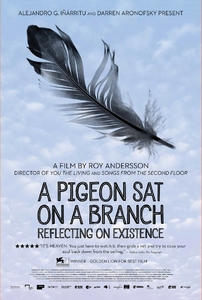
Movies
Reviews

Review: A Pigeon Sat on a Branch Reflecting on Existence
Filed under: Reviews
The films of Roy Andersson are not for everyone, in the same manner that the films of another Anderson, Wes, are also not for all tastes. Is there a connection between these two filmmakers? No, not really. Well, perhaps. Let's see. Their visual styles are both immaculately composed and dryly funny. There are few filmmakers as visually arresting as these two, but they bear little else in common. One did not influence the other. I merely mention the names as a point of visual reference.
I've met those who claim to despise Wes Anderson's films for the very reasons that I enjoy them. The same could be said of Roy Andersson's work. However, fans of Joel and Ethan Coen, David Lynch, Jim Jarmusch, Aki Kaurismäki, or even Mike Judge would find themselves at home in this peculiar cinematic world.
Andersson's newest, A Pigeon Sat On A Branch Reflecting On Existence is the closing chapter of a trilogy that began in 2000 with Songs From The Second Floor, and continued with You, The Living in 2007. In his third installment, he opens with a title card, explaining that the trilogy has examined the subject of "being a human being." I imagine Andersson chuckling to himself as he phrased that title card. Indeed, the films are about what it's like to be a human being, which simultaneously explains everything, and nothing. Thankfully, A Pigeon Sat On A Branch Reflecting On Existence is laugh out loud hilarious.
The film is composed of a series of peripherally connected vignettes, in which some characters recur throughout the film and others show up for just a brief moment. If the narrative --a term used rather loosely here-- contains protagonists, they would be Jonathan (Holger Andersson) and Sam (Nils Westblom) two bumbling salesmen, hocking novelty items such as fake vampire teeth and other equally dismal products.
"We're in the entertainment business," claims Sam to their potential customers, who stare back with a bored indifference. Jonathan is low on patience when dealing with the increasingly sensitive Sam, who frequently breaks down crying in public. Times are apparently tough, as the salesmen are stuck living in a stringently regimented men's hotel.
The only characters more pitiful than the salesmen are their customers, of which they have very few. When Jonathan and Sam inquire about an outstanding payment, the store's owner hides under a blanket, shouting: "I have no money! I have no money!" The two salesmen look on, weakly threatening to repossess their valueless wares.
In one of the most emotionally moving sequences, a faded memory of an old man in a bar, we drift back to 1943 and perhaps, the very reason the man chose to haunt this particular bar for the next 60 years. It's a sweet and rousing section of the film, a respectful eulogy to the archetypal old drunk. The somber nostalgia of that sequence is starkly contrasted later in the film by Andersson's assault (and it is an assault) on the dark history of Europe.
The film ends with an unsettling metaphor for the European colonization of Africa, a disturbingly bleak sequence in which Sam finds himself transported to a different time and place. To be vague, the scene involves a group of African slaves and a large mechanical device. What is the significance of this nightmare? Even Sam cannot bring himself to describe the ugliness on display in that vision.
Andersson's sense of humour is dark and pessimistic, and yet, his film's are touching and observantly human. He's deeply interested in the sadness of the human condition. Many of his characters are hopeless and pathetic, seemingly doomed to wander the earth bewildered and covered in dust. Occasionally they witness horrific acts of cruelty, such as the tortured laboratory monkey who can comprehend its agony no more than any other figure in this film. Other times, grinning in the face of banality, they will cheerfully proclaim: "Looks like it's Wednesday again."
The film is not without its drawbacks. What A Pigeon Sat On A Branch Reflecting On Existence lacks is the vast sense of scope found in the earlier films. Those deep, cavernous interior locations that seemed to go on forever are forgotten in favor of smaller, more contained settings. There are cleverly absurdist moments involving King Charles the 12th of Sweden which only scrapes at the surface of that scope.
It also lacks the whimsical sense of discovery found in Songs From The Second Floor. Seeing that film for the first time, I was seeing something totally new. Watching A Pigeon Sat On A Branch Reflecting On Existence, we're seeing another variation on a style and on some level, a theme that we've seen before. It's undeniably fascinating but admittedly, fails to surpass what we've already seen.
I also realize that for many filmgoers, this will be their first taste of the great Roy Andersson's work. In which case, I strongly recommend seeking out A Pigeon Sat On A Branch Reflecting On Existence for the film's dark sense of humour and abundant richness of imagery.
I promise you have never seen anything like it.
Tags: Roy Andersson, Wes Anderson, A Pigeon Sat on a Branch Reflecting on Existence, Holger Andersson, Nils Westblom, Songs From The Second Floor
Related Posts
Tony Hinds is a Canadian writer who studied film at the University of Winnipeg. In addition to ShowbizMonkeys.com, Tony has reviewed films for Step On Magazine and The Uniter. You can find Tony on Twitter.






Comments Posted (